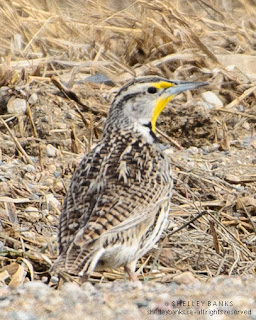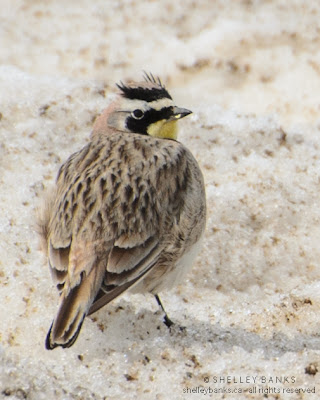What birds come to our Regina backyard feeders? Right now,
Dark-eyed Juncos,
House Finches, Common Redpolls, House Sparrows,
Red-breasted Nuthatches, and one
American Tree Sparrow. All of these birds were in my yard yesterday; all but two of these pictures were taken then.
(Note: This post is only one of many on my blog that deal with birds seen feeding in gardens and lawns in my part of Regina, Saskatchewan. Use the index for more, or search "backyard.")
There is quite a range in size with these birds, from the tiny wintering
Common Redpolls through our seasonal birds, up to the large male resident House Sparrows. And range of songs, too. I love having the migrating native prairie and northern song birds, as they really sound lovely.
First, a few of the
Redpolls, from a red-breasted male and paler female, to a
copper-headed bird. These very small birds have been here most of the winter, but will soon be heading north to the Boreal Forest and/or tundra. (Apparently, we had such a high number this winter because the white birch seed crop was poor in the north... So says the
e-bird forecast.)
 |
| Male Common Redpoll in the lilac branches. © SB |
 |
| Brightly capped female Common Redpoll. © SB |
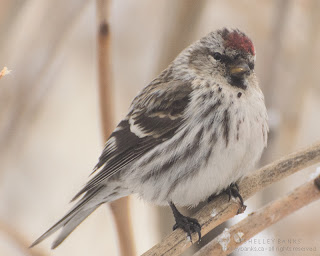 |
Copper-topped Common Redpoll - perhaps a variant
or young bird. © SB |
Next, the
House Sparrows — our constant and noisy companions, whose call sounds to me like they are accusing us of being, "CHEAP!" The male looks quite threatening, with his scowly-face markings, while the female is a gentle looking beige and brown.
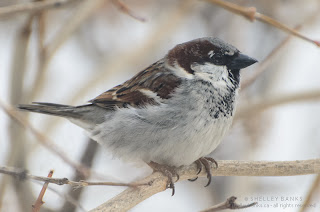 |
| Male House Sparrow - a bird that always looks angry! © SB |
 |
| The much gentler-looking female House Sparrow. © SB |
Among my ongoing favourites are the
House Finches. (I was surprised to learn that they weren't common in Saskatchewan until fairly recently — but more on that another time.) The most common
finches are red and scarlet, but sometimes we see birds with orange and yellow markings, too. I used to wonder if these were young birds, but I understand that these are a variant. Yeah for variety!)
Their primary ID factors, for me at least, are the finches' delicate breast stripes and slightly crossed, better-to-open seeds bills. The females are brown, the males more colourful.
 |
| Female House Finch © SB |
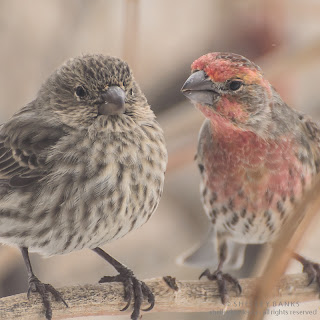 |
Another female House Finch, somewhat unimpressed
by her potential mate, an orange male House Finch. © SB |
 |
| Male House Finch, showing head and back colour. © SB |
 |
| Pale yellow male House Finch. © SB |
 |
Another orange House Finch -
I love this one's clear marking! © SB |
The
Dark-eyed Juncos are seasonal visitors. We started seeing them a couple of weeks ago, and now have up to a dozen at a time in the yard. (The one below is looking particularly dark-eyed, shadowed and in the snow...) The Juncos are easy to identify: Gray on the top, white on the bottom... And when they fly, their tails are white and gray. Love the notched tail they display when perched!
 |
| Grumpy Dark-eyed Junco in snow. © SB |
A
Red-breasted Nuthatch frequently shows up, usually at the suet feeder. There are several in our neighbourhood, and I often see groups of three or four in the front yard, but our backyard visitor is always solitary. It's also usually upside-down; I rotated this picture to more clearly show its head.
 |
| Red-breasted Nuthatch, feeding on seeds in suet. © SB |
And, finally, another shot of the
American Tree Sparrow that started visiting us in the past few days. The
Tree Sparrow's red head and red eye lines are its most obvious marker.
 |
| American Tree Sparrow. © SB |
We expect more sparrows and other finches will soon find their way north to visit.
What are these? Common Redpolls, House Sparrows, House Finches, Dark-eyed Junco, a Red-breasted Nuthatch, and an American Tree Sparrow.
Location: Backyard, Regina, Saskatchewan, Canada.
Photo dates: All taken April 7, 2013, except the Nuthatch (March 31, 2013) and the male House Sparrow (April 3, 2013). All were in the backyard April 7, 2013...
~~~~~










